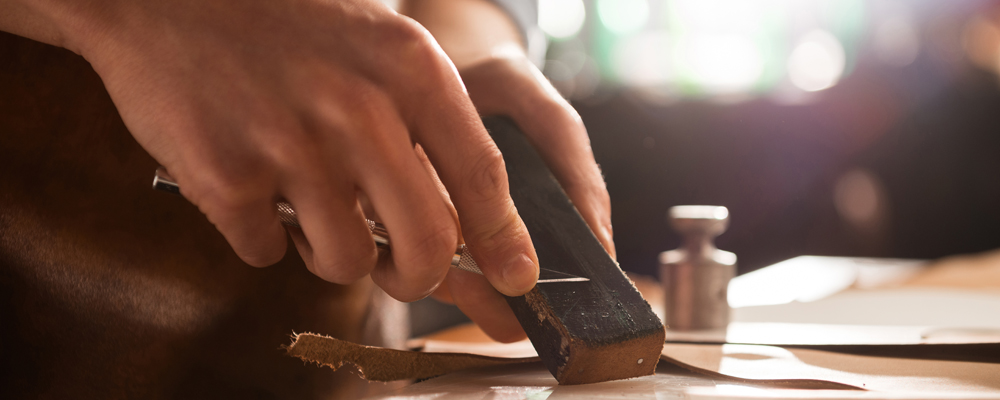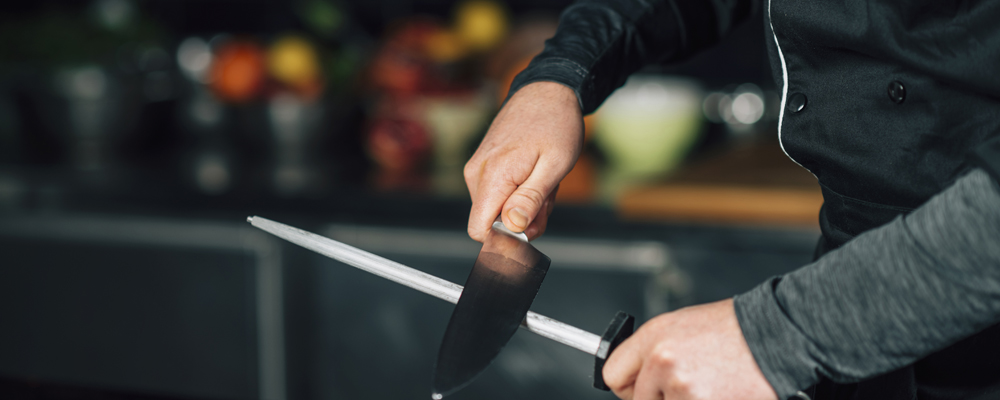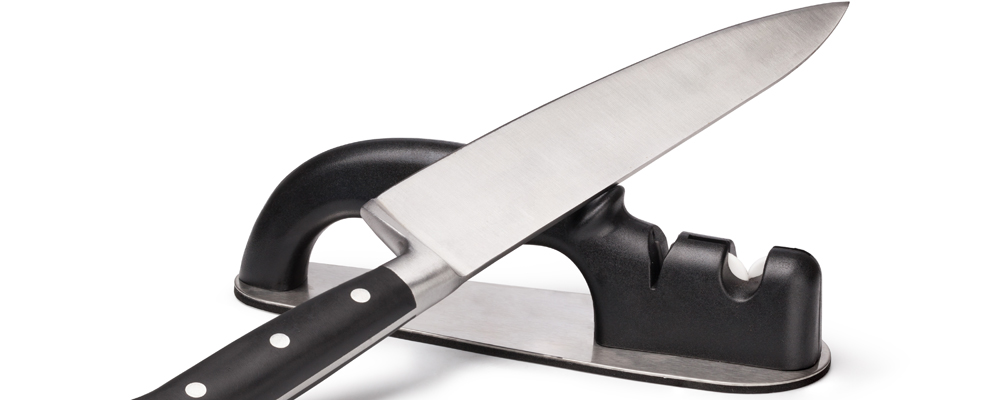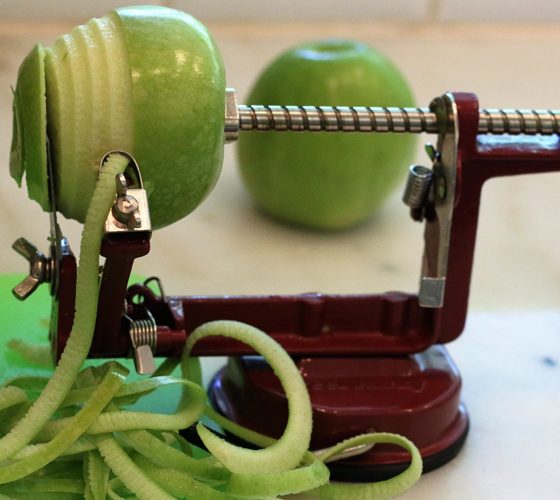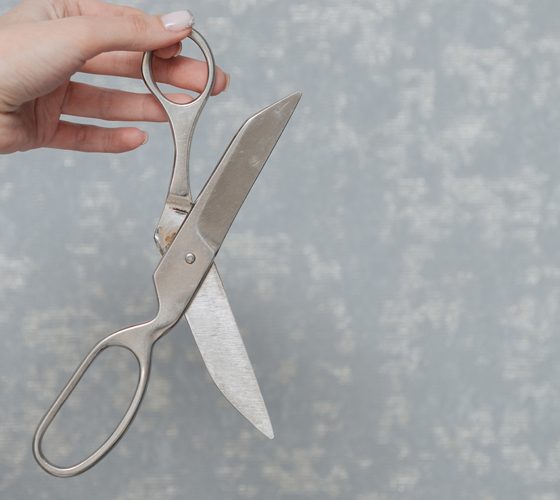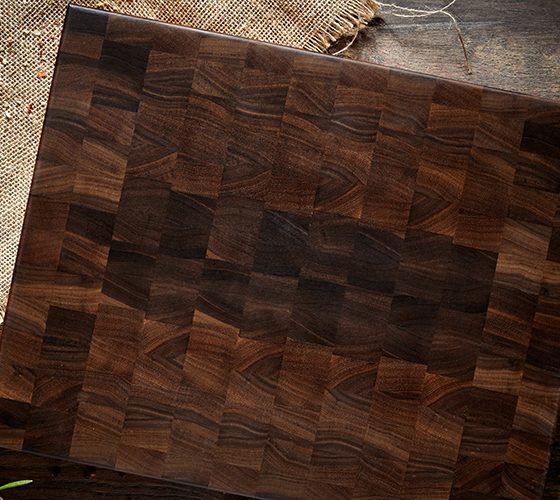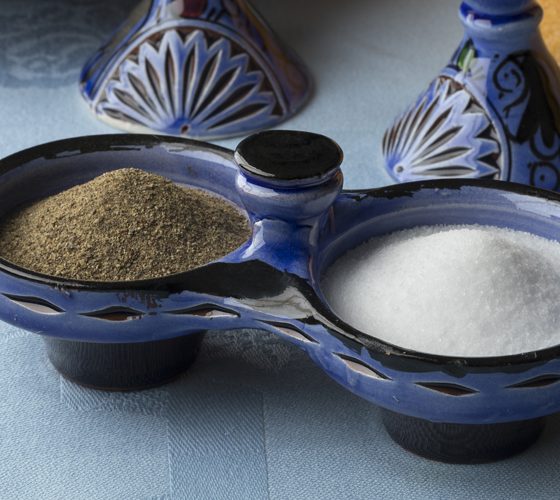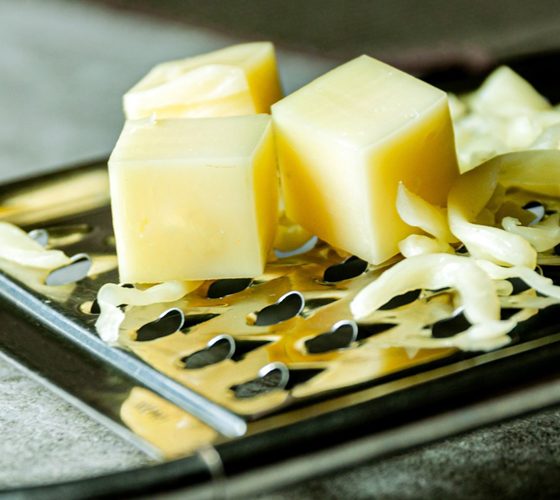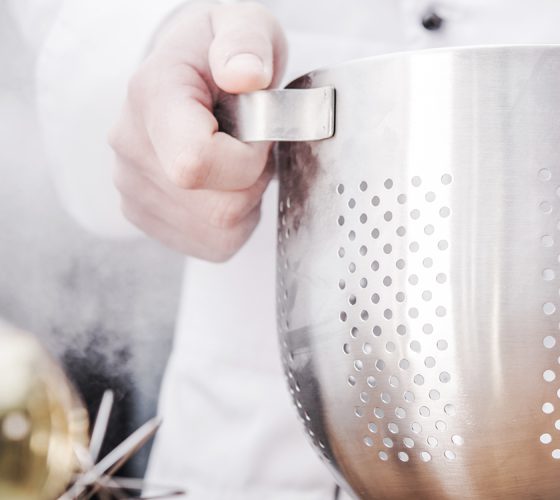A great set of sharp knives is one of the best investments you can make for your kitchen. Yet, no matter how amazing your knives are, they will eventually dull. Even the best knife inevitably dulls with use if you have no way to keep it sharp. Therefore, you need to also look into investing in a high-quality sharpener to prolong the life of your knives and keep them honed to a razor’s edge over the years.
Not only does having, and using, a sharpener keeps your knives doing their best work, sharp blades will save you time and potential nicks and cuts as well.
Finding the best knife sharpener for your household can be a complicated task. You will want one that is quick and easy to use with your current skill level, effective, and sized to fit your kitchen.
View The Best Knife Sharpener Below
1. AccuSharp 001C Knife Sharpener

Although deceptively small and simple in design, the AccuSharp 001C Knife Sharpener more than earns its place atop our list of the best knife sharpeners. With sharpening blades composed of diamond-honed tungsten carbide, it is capable of sharpening virtually any blade in a matter of moments.
It has an ergonomic handle with finger guard to give you a firm grip and to protect your hands while sharpening your blades. Plus, with replacement sharpening blades available, it is sure to see you through many years to come.
This manual knife sharpener works on many types of knives, including serrated knives, making it one of the more versatile options available.
Pros:
+ Mess-free sharpening
+ Safe and easy to use
+ Works on any blade
Why We Like It – Do not be fooled by its small size, the AccuSharp 001C Knife Sharpener is a heavy hitter capable of sharpening virtually any blade with minimal mess and fuss.
2. Chef’s Choice Trizor XV EdgeSelect Professional Electric Knife Sharpener

Electric sharpeners are best known for the speed and ease of use they have over other sharpening methods. The Chef’s Choice 15 Trizor XV takes this up to another couple notches by offering three separate sharpening settings to see to the maintenance of most knife types. Two of the three Trizor XV settings employ diamond abrasives for maximum sharpening capable of converting a standard 20-degree blade to the 15 degrees preferred by most chefs.
The Trizor XV’s patented spring guides and simple on/off switch make it amazingly simple to use. Plus, the Trizor XV is backed by a three-year limited warranty, making it a worry-free investment.
Pros:
+ Electric knife sharpener
+ Diamond abrasives for fast, dependable sharpening
+ 3 year limited warranty
Why We Like It – With three stages of sharpening available and handy guides for foolproof sharpening, the Chef’s Choice 15 Trizor XV is one of the best electric sharpeners you can get for your kitchen.
3. Smith’s CCKS 2-Step Knife Sharpener

The Smith’s CCKS 2-Step Knife Sharpener is a manual knife sharpener that takes the guesswork out of the sharpening process. Two tungsten carbide blades, already set at the appropriate sharpening angle, provide a fast and easy knife sharpening. The other side features two ceramic blades suited to refining and maintaining an already sharp blade.
This small, simplified manual knife sharpener has rubber feet and textured handles for secure handling. It is sized to work on most knives from your larger kitchen knives to filet and paring knives or a simple pocket knife. Its compact, lightweight design means it stores away easily. Or, you can thread it onto a lanyard to keep it close at hand for convenient use while working.
Pros:
+ Manual knife sharpener
+ Dual-sided for full sharpening
+ Small sized for easy storage
Why We Like It – This is the small and straightforward solution for those who just want an easy to use means of sharpening and maintaining their knives.
4. Utopia Kitchen Knife Steel Sharpening Rod

While honing steel, no matter the material it is made from is not intended for the sharpening of knives, a high quality honing rod is an integral part of knife sharpening. They may be used before or after use to maintain a knife’s sharpness and the straightness of the blade.
Constructed of carbon steel, this honing steel is made to last. The 10-inch length is ideal for most kitchens. Plus, the rubber handle is ergonomically designed to be comfortable to use for anyone, no matter which hand is your dominant one. Care is simple, and its slip-resistant design means it is safe to use.
Pros:
+ Carbon steel
+ Ergonomic handle fits right or left hands
+ Slip-resistant
Why We Like It – This honing rod, with an ergonomic handle comfortable for anyone to use, is a perfect complement to any kit designed to see to the sharpening of your knives.
5. KITCHELLENCE Kitchen Knife Sharpener

This is one of the best knife sharpeners among the manual sharpeners available on the market today. It has three separate groves fitted with three different grits to handle any sharpening job on most non-serrated blades. The heavy diamond grit blades can smooth and repair heavily damaged knives. The tungsten steel blades provide a medium grit for most knife sharpening jobs, and ceramic blades give them a finely honed edge.
It has an ergonomic handle that can be used with either the right or left hand with ease, and it comes with a cut-resistant glove to protect your hands. Plus, the black and stainless steel design fit with any kitchen decor.
Pros:
+ 3 grits for full knife maintenance
+ Ergonomic handle fits right or left hands
+ Cut resistant glove included
+ Backed by a money-back guarantee
Why We Like It – With three grit levels available for use, this sharpener is like getting three-knife sharpeners in one.
6. SunrisePro Supreme Knife Sharpener

When it comes to kitchen work, sharp knives are essential. Manual knife sharpeners are the more economical solution for keeping your knives sharpened, but holding a manual knife sharpener while also pulling a blade through it can be a frightening prospect. SunrisePro Supreme Knife Sharpener takes the fear out of using a manual sharpener with its suction securing feature. It adheres to any smooth, flat surface to make holding the sharpener unnecessary, so all you have to do is pull your knives through the sharpening blades a few times.
Plus, it is backed by a money-back guarantee, so there’s no risk!
Pros:
+ Angle of sharpening is preset
+ Suction base for safety
+ Backed by a money-back guarantee
Why We Like It – This is an ideal knife sharpener for those who are intimidated by the idea of holding a manual sharpener while sharpening their knives. The suction securing feature makes it virtually hands-free.
7. KitchenIQ 50009 Edge Grip Knife Sharpener
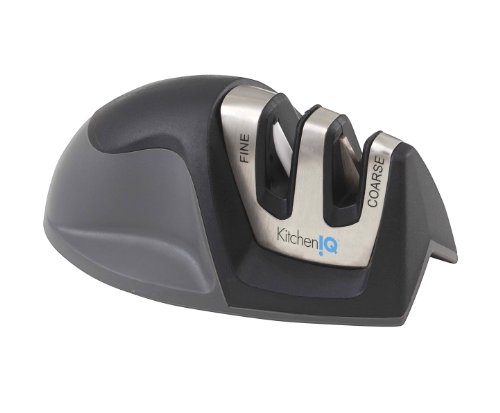
When it comes to knife care, it is better to see your knives hold their edge rather than waiting until they are dulled or damaged. However, it can be challenging to use a knife sharpener regularly without accidentally nicking your countertops, especially when maintaining larger knives.
This is not a problem with the KitchenIQ 50009 Edge Grip Knife Sharpener. Its unique design allows you to brace the sharpener on the edge of your countertop while sharpening your knives. This keeps the knives up and away from your counters during the entire sharpening process, meaning your countertops stay nick and scratch-free.
Pros:
+ Coarse and fine grit blades
+ Non-slip bottom
+ Edge grip bottom prevents countertop damage
Why We Like It – See to it all your knives keep their sharp blades with regular sharpening sessions. The KitchenIQ 50009 Edge Grip Knife Sharpener makes sure you can do this while also protecting your countertops.
8. Presto EverSharp Electric Knife Sharpener

If you want a well-sized and effective electric sharpener that looks good enough to keep out and ready to use any time, the Presto EverSharp Electric Knife Sharpener may be the best option for you. Step one has a coarse sapphirite grinding wheel to sharpen a dull blade, and step two has a fine grit grinding wheel to refine the edge. Both steps offer guides to ensure you hold the blade at the proper sharpening angle for each side.
A sleek black and stainless steel design will fit into your kitchen decor, and three suction cups hold it firmly in place.
Pros:
+ Coarse and fine grinding wheels
+ Electric sharpener for fast sharpening
+ 3 suction cups secure the sharpener to your countertop
Why We Like It – Fast and easy to use knife sharpening wrapped in a stylish black and stainless steel package to fit any kitchen decor make this an ideal knife sharpener to have set up and ready to go any time.
9. BulbHead Bavarian Edge Kitchen Knife Sharpener

The BulbHead Bavarian Edge Kitchen Knife Sharpener is the best choice for knife lovers. The spring action arms, both capable of independent movement, give this model flexibility unmatched by other knife sharpeners. It can conform to your blade, making it ideal for working on different types of blades.
The sharpening arms are made from tungsten carbide and made to rival the effectiveness of even the best sharpening stones. It is lightweight, small, and easily portable for ease of use.
The sharpener comes with an instruction manual on how to get the most out of it. It is capable of sharpening, honing, and polishing blades of all types.
Pros:
+ Spring action arms conform to any knife
+ Works on all different types of blades
+ Comes with an instruction booklet
Why We Like It – The spring action arms give the BulbHead Bavarian Edge Kitchen Knife Sharpener flexibility that is unmatched.
10. Priority Chef Knife Sharpener

Very few materials can beat diamonds for durability in jobs like being used to sharpen a knife. The Priority Chef Knife Sharpener offers courses and fine grinding wheels using diamond and ceramic respectively to sharpen and repair old knives and see to the maintenance of sharp ones.
The sharpener has a non-slip base for a secure grip on the work surface and an ergonomic handle for sure, comfortable use. This ensures the best sharpening with the highest level of safety possible.
The wheels inside the knife sharpener are made with the ideal angle built-in for ease of use, and a money-back guarantee backs it.
Pros:
+ Coarse and fine grit sharpening wheels
+ Ergonomic handle
+ Non-slip base
+ Backed by a money-back guarantee
Why We Like It – When it comes to sharpening materials, it is difficult to beat diamond, and that is exactly what this manual sharpener employs to see to your knives’ maintenance.
Knife Sharpeners Buyer’s Guide
What is the best knife sharpener to buy?
Which knife sharpener will be the best knife sharpener for you, and your kitchen will depend on a few different factors. What knives and knife types do you use? How often do you use your knives? How many knives do you use frequently, and how do you see their handling and maintenance?
The simplest knife sharpeners are good, old fashioned whetstones. These can be natural or synthetic stones where water or oil is used to assist in the process of using these abrasive surfaces to hone the existing edge of your blade. A whetstone requires a fair amount of skill and several passes to work properly. Still, they can help you maintain a razor-sharp blade for years since they remove very little material to do their work when compared with other sharpening methods.
If you are interested in using a whetstone to sharpen and maintain your blades but have not used one before, there are several tutorials available online and on YouTube as well. Peruse several of these to get a rough idea of how to utilize your whetstone. However, you must expect to perfect the needed technique to take time. Even if all of your knives are set to the same angle, it takes time and practice to maintain this angle while sharpening every time. Yet, knives come with a range of cutting edge degrees from 10 to 20 degrees, which can further complicate the process.
It is because of this difficulty we have excluded whetstones from our list of knife sharpeners being tested and reviewed. We wanted the list to be helpful to all skill levels, and for the broadest range of cooks, so we decided to stick with manual or electric knife sharpeners since these methods are simpler to employ immediately.
Both manual and electric knife sharpeners make it faster and easier to achieve a sharp edge for your blades. The majority of them have the sharpening angle needed preset for you. This removes the need to make sure you hold the blade just right, meaning they are relatively foolproof, and they generally require fewer passes to hone a blade to a sharp edge. In short, a manual or electric knife sharpener is an easy to use method for keeping your knives sharp.
However, most manual or electric knife sharpeners do this by using a V-shaped notch to give your knives an utterly new edge using a coarse grit. This means much more of your knives’ material is removed each time you sharpen them than is necessary with a whetstone. Therefore, these are the best knife sharpener options for those who will need to sharpen their knives sparingly or who do not have an issue purchasing new knives regularly.
Knife sharpeners that offer a range of grits from coarse to fine help mitigate this problem by offering a less drastic means of honing and maintaining the blade without removing more material than is strictly necessary. To get the best out of these sharpeners, you should run the blade through the fine grit option a time or two before or after each time it is used.
These blades are typically composed of ceramic, and they remove very little metal from the knife. They are meant to merely polish, hone, and maintain an already razor edge. Reserve a few passes through the medium or coarse grit slots for when your knife has become nicked or dulled. With regular maintenance, you should only have to sharpen your knives every few dozen uses truly. This will preserve the metal used to make your blade, thus extending its life.
Related to knife sharpeners, but not actually a sharpener itself, is honing steel. These long, often ceramic coated, steel rods are used to keep a blade’s edge straight. This helps maintain the knife between sharpening sessions to prolong the life of each knife further. These are a wonderful tool to have in your arsenal to use for your best knives. Regular use of a honing steel will maintain the integrity of a knife, helping it work better and reduce the frequency with which you need to sharpen it, thus prolonging the life of each knife.
Knife sharpeners come in a range of sizes, and some offer multiple grit settings or just a single grit. These are also factors you need to consider when determining which is the best knife sharpener for your kitchen. While grit has a great deal to do with the actual sharpening of your blades, the size of the knife sharpener itself has little to no influence on its ability to hone a knife blade to a sharp edge or how easy to use it may be. Keep the size of your kitchen and the storage space available when determining which sizes you can consider. The grit and settings available are the larger factors to consider.
What grits are there, and what are they used to correct? A fine grit stone with a setting of 4000 and above is used to refine an edge. Medium grit, with a setting between 1000 and 3000, is the most commonly used. This is the grit level you want to use for most sharpening sessions. It is best used for knives that have gone dull but that are not damaged. To repair damaged blades, or those with chips, nicks, and scratches, you would want to choose a course grit or one labeled as less than 1000.
Remember, the coarser the grit, the more metal will be removed during sharpening. So you do not want to use a grit that is too coarse for the job at hand as this will needlessly shorten the life of your knife blade.
What about serrated knives? Will any knife sharpener work to hone those as well?
No. The vast majority of manual or electric knife sharpeners are not capable of sharpening a serrated knife, and the reason is two-fold. First, a serrated blade will hold its edge for much longer than a smooth blade, such as most types of knives. Even when it does begin to dull, a serrated knife will continue to work well enough for most jobs without becoming dangerous such as most dull knives. Then there is the shape of the blade itself. Due to the groves in the blade of a serrated knife, the sharpening process is much different.
If you have a high-quality serrated knife or two, you will want to either search for knife sharpeners with a setting specifically for them. Otherwise, you will need a steel honing rod, which needs to be used on each individual serration for proper sharpening. Your other option would be to seek out a professional to help you with that particular knife.
What is the best knife sharpener for pocket knives?
Due to their size, electric or even manual knife sharpeners are usually not a great fit for a pocket knife. While they will work, most of these sharpeners are generally designed for larger kitchen knives. This can make them too bulky to work well with a smaller pocket knife blade.
When it comes to honing the edge of a dulled pocket knife, sharpening stones will serve you best. A sharpening stone is typically made from a few different, very hard materials such as ceramic, natural stone, or diamond. Most come in a single inch thickness, and they can remove a good deal of material. This makes them ideal to use when sharpening very dull knives.
As stated above, there is a bit of a learning curve when using a sharpening stone for the sharpening process. However, once you have the process down, it only takes a few minutes of steady work to get sharp knives. And when it comes to getting your knives to work, sharp blades are essential.
A sharpening steel or knife hone can also be useful for use with a pocket knife, though they do not actually act like a knives sharpener. Both items remove very little material, so they cannot fully sharpen a dull blade. However, to see the best results from your pocket knife, your blade must be as straight as it is sharp. That is where a knife hone or sharpening steel comes in. Both tools work best to keep a blade straight and honed.
This said, there are a few smaller knife sharpeners that will work for sharpening a pocket knife, and there are even more which can handle larger utility knives such as hunting knives. The models that work best are the smaller, more compact ones such as the AccuSharp 001C Knife Sharpener, the Smith’s CCKS 2-Step Knife Sharpener, or the KitchenIQ 50009 Edge Grip Knife Sharpener.
To avoid issues with cross-contamination, we would suggest one of these options be reserved for maintaining pocket knives or utility knives. At the same time, another sharpener, or a duplicate, is dedicated to maintaining your kitchen knives. However, in a pinch, thorough cleaning before using any sharpeners can suffice. It is an excellent procedure to have in place for utilizing sharpeners in any case.
What do chefs use to sharpen their knives?
The answer to this question is varied and individual as the chefs themselves, but there are a few trends. A kitchen’s culture, as well as the budget for kit maintenance, also plays a significant role in how frequently and in what manner a professional chef sharpens their knives.
To fully understand this process, you must first understand two terms and how they differ. There is sharpening, and then there is honing. Both have their place in knife maintenance, but they are two different things.
Sharpening a knife involves taking a dulled blade and returning it to a sharp edge. This process usually involves removing a fair bit of material from kitchen knives in order to make them sharp enough to get the job done, and this is true for different types of knives.
Honing involves much less metal removal. This process is best used on a daily basis to help keep each of the blades straight and to maintain their already sharp edge. Honing will not make a dull knife sharp again.
Not every chef has the time to sharpen all of their knives every day, if at all. There are professional sharpening services available for professional kitchens and restaurants. So some chefs either send their knives to these services for a professional sharpening regularly, or the service may come to them. Most of these services use a grinder wheel to make quick work of sharpening dozens of kitchen knives in a session, and the service sends someone to return periodically. However, these knife sharpening services tend to be costly, with a quality that varies widely from one individual or service to the next, and they are not a viable option for most home cooks.
A few professional chefs make use of an electric knife sharpener or, more often, a manual version of the same. They are often easy to use and speed the process, but the amount of material removed from the knives makes these less popular among pros who use their knives frequently every day. When used to keep up with the demand to sharpen knives, one finds in a restaurant kitchen. Even the best electric sharpener can shorten the life of a knife set rather than prolong it.
Perhaps most popular among professional chefs are whetstones and tri-stones. While there is a learning curve to using any kind of sharpening stone, they are one of the most tried and true methods to sharpen knives and keep knives sharp over the long run while also preserving the blades for as long as possible. Once a chef has mastered the sharpening angle needed for such a manual sharpener, knife maintenance takes only a few minutes each day either before or after their shift.
This may seem like an inefficient use of time, but dull knives have no place in any kitchen, much less the fast-paced, demanding environment that is a professional kitchen during the lunch and dinner rush. Taking the time to properly sharpen a knife not only makes using it faster and easier, it makes using it safer as well. A dull knife may slip. It will require you to push with much more force than is really necessary, thus “encouraging” accidental slips or just flat out crushing the food instead of slicing it.
A sharp knife is far easier to use. It is much more likely to cut into even hard vegetables without slipping or requiring excessive force. This helps keep delicate foods from being crushed and prevents slips that can be disastrous. Plus, the easier a knife can slice through the items it must cut, the faster the chef can prepare ingredients for their dishes. This alone cuts down on time and increases productivity in the kitchen. Add in the potential time lost to tending an accidental injury, often including a trip to the emergency room, and disinfecting the kitchen after such an accident, and the benefits of daily knife sharpening sessions become clear.
Additionally, whetstones and tri-stones tend to be cost-effective, and they last a long time while also prolonging the life of most kitchen knives over the use of a manual knife sharpener or electric sharpener.
Are knife sharpeners worth it?
You may think knives are dangerous because they are sharp tools, but when it comes to working with knives, a dull knife is a dangerous knife. The duller the blade, the more force is required to do the job. The more force is put behind a blade, the more force it will impact anything that gets in the way if and when it slips. Plus, the longer you use a dull knife, the more accustomed you become to using a particular level of force when using the knife. So waiting too long to use a knife sharpener can also lead to accidents even after you have sharpened your knives.
Even if you take the fear factor out of the equation, having a good knife sharpener and using it frequently will save you a ton of time in the kitchen. With today’s hectic lifestyle, any time saved is a benefit. Otherwise, cookbooks devoted to recipes requiring thirty minutes or less to prepare would not be anywhere near as popular as they are today.
As mentioned above, traditional whetstones or tri-stones, are often cost-effective means of keeping a knife razor-sharp for as long as possible. However, using them can be difficult at first, and the lower need for constant sharpening means they are not always the best method for most home cooks.
A good manual or electric sharpener is usually a more efficient means of knife maintenance for home kitchens. A quick session every few months and a pass or two over a honing rod or fine grit polishing blades each time a blade is used is often enough to keep a good set of kitchen knives in top condition for years.
Their potential is even more dramatic for those who utilize blades or scissors outside of the kitchen. Not every sharpener is capable of also sharpening scissors, but those that are finding favor with fiber artists and paper crafters alike. After all, the sharper the scissor blades, the cleaner the cut, and there is a reason for memes warning people not to cut paper with a sewing enthusiast’s good fabric scissors!
Finally, look at the average cost of any of the sharpeners listed against even one set of good knives. Without having a sharpener at hand, what other choices do you have regarding your kitchen, pocket, or utility knives and scissors? Working with dull blades is time consuming, dangerous, and it results in poor results. So, you must either put up with this or throw them out and buy a new, costly, and wasteful practice.
Conclusion
When it comes to kitchen work, sharp knives are the best knives. Therefore, you want to see to the maintenance of them regularly, whether that is through the use of electric sharpeners, sharpening stones, or manual sharpeners.
While the simplest available, whetstones can be messy and tend to be the most difficult to use. You must see you are holding the blade at the proper sharpening angle at all times for a particular blade. This is difficult enough, but considering blades can come in 10 degrees, 15 degrees, or 20 degrees, it is easy to become confused.
This is why the majority of the sharpeners listed above are either manual or electric since they simplify the work. Sharp blades are much easier to achieve and maintain through sharpeners such as the Trizor XV, AccuSharp 001C, or even the simple Smith’s CCKS 2-Step Knife Sharpener.



